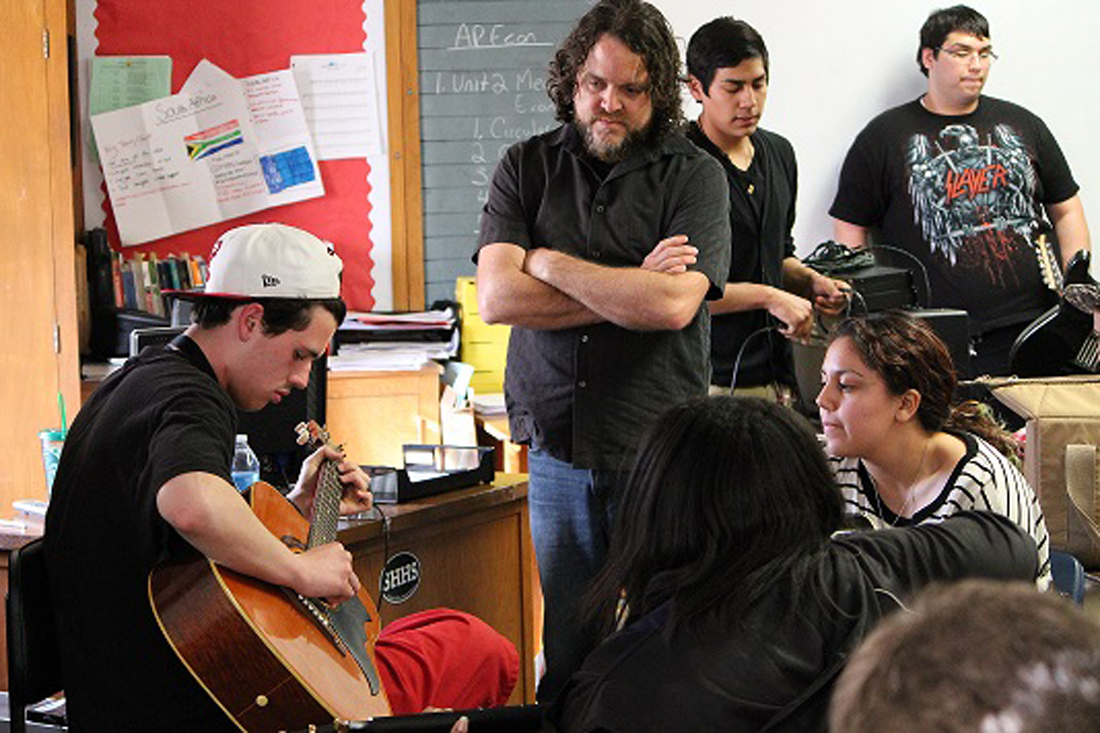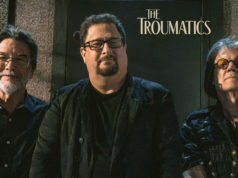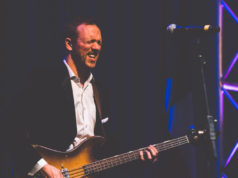Metallica, Slayer, or System of a Down isn’t something you’d expect to hear in a high school classroom. Rock ’n’ roll has never been associated with a good education.
But at South Hills High School in Fort Worth, economics teacher Jim Crye is educating his students not only about budget surpluses and currency rates but also on the proper way to shred.
“This is the one thing I can do where I don’t have to be a judge,” said Crye, who spends his days teaching and his nights playing guitar for his bands Volume Dealer and Primal Concrete Cowboy, a Pantera tribute outfit.
Crye has been running his after-school guitar club at South Hills almost since his first day on the job in 2010. He started the program in response to the school’s growing gang problem. Just a few years ago, he said, not a day would pass without a fight breaking out among rival members. In 2006, a student was shot and wounded by a Fort Worth police officer during an altercation. In 2008, another student was shot by a police officer after a reported struggle. And in 2010, two students were accused of killing an honors student.
The administration wanted teachers to come up with extracurricular activities to connect with the kids. Some teachers started art clubs; others a graffiti club and a ping-pong club. “We were just trying to come up with innovative ideas, out-of-the-box thinking on ways to get kids more involved,” said Assistant Principal Brian Rosatelli.
All of the programs received some government funding –– until the state pulled the plug last year, Crye said.
While some of the other clubs died, Crye’s is still going strong. The 42-year-old native Fort Worthian donates time, equipment, and money (buying strings and other incidentals) to the cause. He’s also down to earth, Rosatelli said. Teaching students from beginner to advanced levels, Crye speaks the kids’ lingo and makes them feel comfortable. (To participate, guitar club members must be passing their core classes.)
“This is the perfect outlet [where students can] come and hang out with an adult who’s offering something besides math and science,” Rosatelli said. “If I had more time, I’d go learn from him.”
Crye said he’s looking for “the next Jimi Hendrix” –– and he’s only half joking.
On a recent Friday afternoon in a small portable building, five students were sitting in a circle in front of the classroom, holding acoustic and electric guitars.
On a screen amid posters displaying information on various countries’ economies glowed the instrumental notation or tablature to Metallica’s “Nothing Else Matters.” Four other students stood around an amp and speaker near the door, adjusting the knobs to find just the right tone for guitarists Luis Lopez and Joel Flores, two 18-year-old students whose band, Light the Way, was scheduled to play later in the evening at Tomcats West.
Lopez has taken part in the guitar program since his freshman year. The summer before high school, with nothing much to do, he picked up a guitar, his sister’s Squire acoustic, for the first time. It didn’t take long for him to fall in love with jamming. After he started going to guitar club, he told one of his friends about it, and word soon spread among the school’s 1,400 students. Now there are about a dozen club members.
“It means a lot to me that he’s running this program,” Lopez said of Crye, “because not only does he teach us how to play better, but he also lets us know the mistakes he has made as a musician so we won’t do the same and avoid those little things that affect the performance. He even comes out to my shows and supports my band. I could not ask for a better teacher/music mentor.”
Standing next to Lopez was Mark Guerrero, 18, who graduated last year but still comes to the guitar program every Friday. He started attending two years ago, but his love of “real metal” (thrash) and his connection to “Mr. Crye” keep bringing him back.
Crye said had started a similar program at Eastern Hills High School, where he taught for two years and where gangs are a way of life for many students. It was a success. Since South Hills was struggling with a similar problem, Crye figured he would bust out the guitars again and see what happened.
“I was like, ‘I need something to do with these kids because there’s no telling what they’re going home to,’ ” he said. “I figured there were some rock ’n’ roll guitar players out there.”
Crye is one of the best-respected guitarists in North Texas. He’s been playing since the sixth grade, when a friend introduced him to KISS’ Double Platinum. As the music roared from his friend’s stereo’s speakers, a younger Crye stared at the painted faces inside the album. He knew he wanted to be Ace Frehley and spent hours practicing. The first songs he learned were “Firehouse” by KISS and “Crazy Train” by Ozzy Osbourne.
He played his first gig in 1988, at Joe’s Garage. He was lucky enough to be part of the metal scene when local bands like Pantera, Gammacide, and Rigor Mortis were destroying stages across North Texas.
Not long after high school, Crye did the family thing, and bills followed. He decided to finish college and find a career. In 2006, with his degree from the University of Texas at Arlington and teaching certificate in hand, he received a phone call from a recruiter with the Fort Worth school district: “ ‘Man,’ ” Crye recalled his recruiter saying, “ ‘I’ve got a perfect job for you. You work 187 days a year and get 14 weeks off.’
“Then you get into it,” Crye said, “and it’s like, ‘Oh, hell.’ ”
Back at South Hills, the guitar club meeting was over, the students packing up their instruments. Next week they’re supposed to bring a song they want to learn — songs are an important early part of the process. In the corner of the room, sophomore Daniel Wyatt was still hanging around, playing “Foolin’” by Def Leppard on a battered acoustic. This had been his first day of guitar club, but he’d helped Crye show chords to other beginners.
Crye walked over, picked up an electric, and asked him to show him the chord progression. Daniel’s eyes lit up, and he grinned as he got the chance to show a teacher how to do something for a change.
“It starts out like this,” Daniel said, strumming out the crunchy riffage.
“Like this?” Crye asked, following his lead.
“Yeah,” he answered, “but then you need to hit this note right here.”
Crye mimicked the pattern, making only one mistake, which the student quickly pointed out. Several minutes passed before Crye was playing the whole song. Daniel nodded and smiled along with approval.
“You should come back next week,” Crye said.
“I will,” Daniel said.
Teaching him licks empowers his students, Crye said. The approach helps develop bonds and also gives him a tool for motivating the kids to perform better in school.
As soon as Daniel cleared the room, Crye began preparing for the next day. One of the coaches opened the door.
“Hey, man,” the coach said. “That dude said he taught you how to play.”
“He taught me how to play ‘Foolin’,” Crye said. “But he can play pretty good.”
“That’s why I sent him over here. I told him, ‘Go over there and talk to Mr. Crye, man.’ He ain’t a bad kid.”
“He just wants to play and party.”
“Yeah. Don’t we all?” l













First!
Daniel Myatt! That’s my nephew. He rips!
Damn, Jim. That is cool as hell. That is some good stuff you are doing. Proud of you, man.